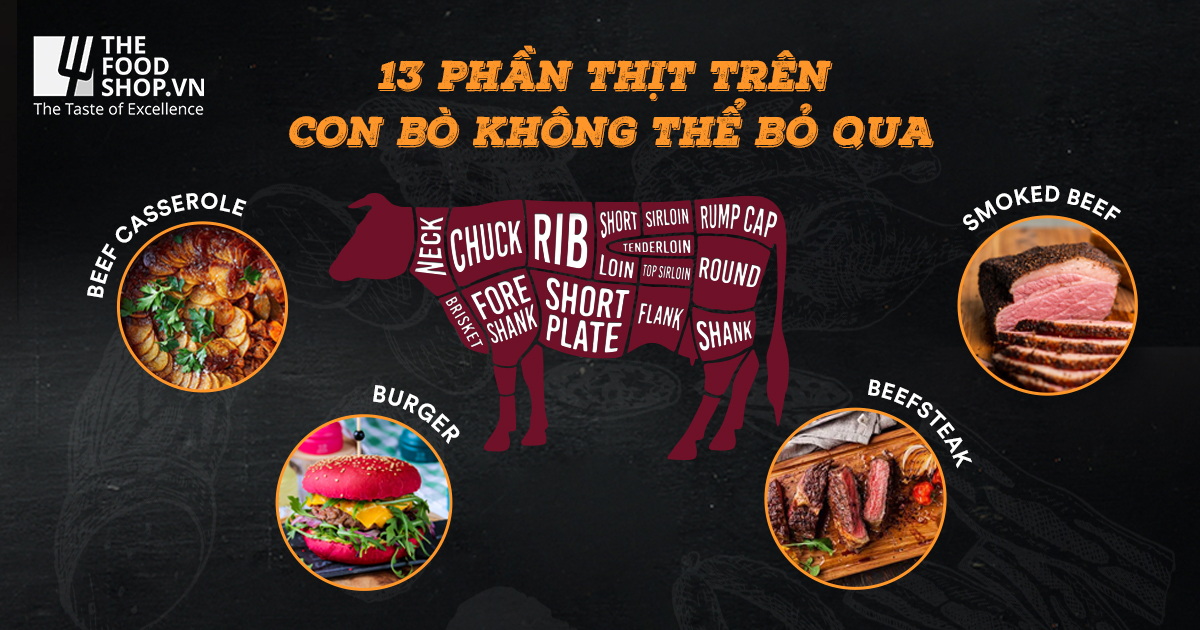Beef is divided into large sections called primal cuts, which you can see in our beef cuts chart. These primal beef cuts, or “primals,” are then broken down further into subprimals or secondary cuts. These are then sliced and chopped into individual steaks, roasts, and other retail cuts.
The most tender cuts of beef, are the ones farthest from the horn and hoof. The toughest areas of the animal are the shoulder and leg muscles because they are worked the most.

1 Head > Cheeks
This cut is the fatty part found on both sides of the face, corresponding to the position of the lower jaw muscles. Its structure is gelatinous (due to the amount of collagen it contains), which allows it to be stewed, braised, or used in various casseroles. These dishes require a slow and long cooking processes.
2 Neck
A meat that connects the head of the cow to the thorax. It is dry, contains a lot of nerves and connective tissue, and is ideal for broths, stews or casseroles.
3 Chuck
Beef chuck produces tough but very flavorful cuts of meat. It is lean and juicy. This primal cut has a good deal of connective tissue which makes it a good choice for braised dishes like beef stew or pot roast, both of which tenderize tough cuts. Due to its fat content, beef chuck is also excellent for making ground beef that produces juicy burgers and ground beef stew.
4 Brisket
Beef brisket is one of the most flavorful cuts of meat, although it is tough and needs to be cooked in just the right way. It’s also a moderately fatty cut of beef, but this can work to your advantage because it tenderizes into succulent, meaty perfection.The characteristically thick, coarse-grained meat needs a lot of time and low-temperature cooking to break down and tenderize. Brisket is frequently used for making pot roast or a to slow cook it in a barbecue or smoker.
5 Shank
The beef shank is the leg of the animal’s thigh. Each side of beef has two shanks, one in the forequarter and one in the hindquarter. It is extremely tough and full of connective tissue. Beef shank is used in making the luxurious Italian dish osso buco, and is ideal for stewing and making broths.
6 Rib: Prime Rib & Ribeye
The beef rib primal cut is used for the traditional standing rib roast (also called prime rib). It’s also the source of the delectable ribeye steak as well as the classic French entrecôte.
Since they’re already tender, steaks and roasts from the beef rib primal can undergo various forms of dry-heat cooking and remain tender.
7 Plate: Short Ribs & Skirt Steak
The beef plate primal includes the short ribs and skirt steak. The skirt steak is extremely flavorful. It’s also a thin piece of meat, allowing you to cook it quickly over high heat. Since it has coarse muscle fibers, be sure to slice it against the grain or it will be chewy.
Beef plate contains a lot of cartilage, especially around the ribs, which is why beef short ribs are ideal for braising. This process of cooking with moist heat at a low temperature will dissolve cartilage and turn it into gelatin.
8 Shortloin: T-bone & Striploin
The short loin is where we find the most desirable cuts of meat. These include T-bone and Striploin. The first-cut steaks are club steaks or bone-in strip steaks. The center-cut steaks are T-bones, of which there may be six or seven. Finally, a butcher may be able to get two or three porterhouse steaks at the sirloin end.
The tenderloin extends from the short loin back into the sirloin. It’s interesting to note that if the tenderloin is removed, there can be no T-bone or porterhouse steaks. Both of these steaks include a section of the tenderloin muscle.
Dry-heat cooking is best for the tender cuts from the short loin.
9 Flank Steak
Beef flank can be cooked on the grill. Since it has tough muscle fibers, it can get even tougher if it’s overcooked, so be careful. The best technique for flank steak is to grill it quickly at a high temperature. Marinating the meat first can help prevent it from drying out, but avoiding overcooking really is the best prevention. When you’re ready to serve it, remember to slice this steak thinly against the grain so it isn’t chewy.
10 Sirloin
The full sirloin is itself subdivided into top sirloin and bottom sirloin. Top sirloin is generally fabricated into steaks that are good for grilling. Since the sirloin is closer to the rear leg of the animal, the muscles get a bit tougher. Still, a first-cut sirloin steak—sometimes called a pin-bone steak because it includes a section of the hip bone—is very similar to a porterhouse.
After separating it from the top sirloin, the bottom sirloin is usually divided into three main components: the tri-tip, ball tip, and flap, which do well with roasting and barbecuing
11 Tenderloin
The most tender cut of beef is the beef tenderloin and it is found within the loin. This is where we get filet mignon, which is made from the very tip of the pointy end of the tenderloin. Chateaubriand is made from the center cut of the tenderloin.
The tenderloin extends from the short loin into the sirloin. The pointy end is actually situated within the short loin, and the section in the sirloin is sometimes called the butt tenderloin. Even so, butchers will often remove the entire tenderloin and sell it whole or as individual steaks and roasts.
Beef tenderloin should only be cooked using dry-heat methods, such as grilling and broiling. The meat is already super tender, so long cooking times are unnecessary. Keep it quick and the heat high.
12 Rump
Rump roast is a boneless piece of beef, cut from the hindquarter that covers the hip bone. It’s made up of three of the five rump muscles that do little work resulting in a mix of textures and levels of tenderness. Full of flavour, rump roast is succulent and tender when roasted or diced for casseroles.
13 Round
The round primal cub usually ends up in 3 different cuts: top round, bottom round (rump roast / eye of round) and the knuckle. Muscles in these cut are fairly lean but slightly tough.
The best way to use these cuts are braising them slowly or turning them into minced meat.
